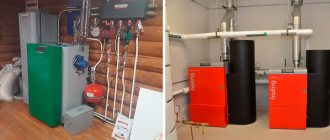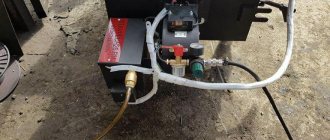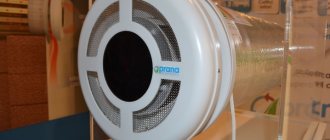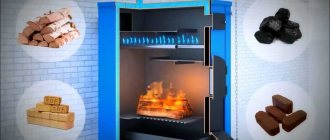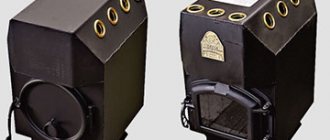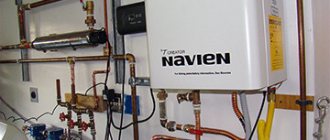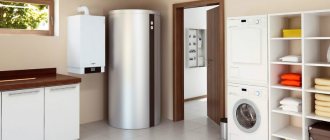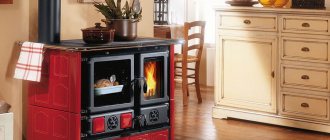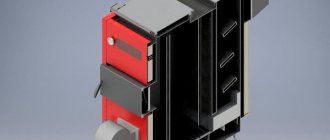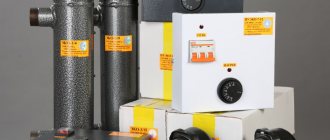Principles for choosing an electric boiler
When purchasing a boiler, there are several other factors to consider.
A very important parameter is the boiler power. For modern OK it varies from 2.5 kW to 60 kW. A weak boiler will not cope with providing heat to the room; an overly powerful one will lead to unreasonable expenditure of electricity and money. The required power is calculated using a special formula. To find out the power, you will need to multiply the area of the room by the specific power (DP). The second indicator is set separately for each region. The figure obtained as a result of multiplication must be divided by 10. Let's say the house is located in the Moscow region, where the UD is 1.2 kW. The area of the house is 200 square meters.
Power adjustment deserves attention when choosing. It comes in two types:
- stepped;
- smooth.
The first type of regulation is used in devices with independent electric heaters. As a rule, with this adjustment option, the boiler can be operated at 25, 50, 75 and 100 percent of the designed power.
For smooth regulation, a rheostat is required.
In cheap units whose power is low, there is no possibility of regulation.
When purchasing an OK, rated for 380 volts, it is necessary to be able to connect a three-phase power line to the house.
You should look at how many circuits the OK is designed for. Electric boilers are usually not used to heat two circuits because they consume too much electricity.
Automation OK is important. It ensures the safety of the unit and allows you to rationally use electricity by regulating the temperature
It is practiced to install two types of thermostats:
- mechanical;
- electronic.
A mechanical type thermostat operates either on bellows filled with gas or liquid, or on bimetallic plates. When the temperature reaches the set value, the thermostat opens the electrical circuit. After the temperature drops below a certain level, the thermostat turns OK again. Mechanical automation is simple, resistant to voltage surges, but not sensitive enough. Deviations from the set temperature by two to three degrees are possible.
Electronic automation can control both the temperature of the room and the coolant. It is characterized by high sensitivity and accuracy in operation. The temperature can be changed using the control panel or by preset programs. The cost of such automation is higher than mechanical.
OK are sold in a basic configuration and with additional options (expansion tank, remote thermostat, etc.) They may or may not be needed. Before abandoning the purchase of additional devices, you should calculate the results of such a step. If you need to purchase them after purchasing the basic version of the electric boiler, it will cost more.
OK housings can be made of various materials (steel, copper, plastic, etc.). The material affects the strength of the body and fire safety.
The price of the unit is influenced by several factors:
- power;
- number of circuits;
- additional options;
- type OK;
- manufacturer.
For example, electric boilers from well-known European brands will, of course, cost more than Chinese or Russian ones. Heating element OKs cost less than electrode or induction ones.
Russian electric boiler "Zota"
VIP class boilers
- The Pikkuwatti electric heating boiler with a power of 13 kW is designed for heating houses or apartments up to 130 m2 with radiators or water heated floors. Can be used as an additional or backup heating source. It works fully automatically, controlling the outside air temperature and the load on the power grid. It has a built-in pump and a 12-liter expansion tank.
- The boiler for the Ecowatti hybrid heating and hot water supply system is adapted to work with a solar collector and a heat pump. Automation starts electrical heating in case of insufficient energy from external sources. The system includes two independent tanks - a buffer tank for an external source and a tank for hot water supply. Unique technical characteristics make the heating system as environmentally friendly and fully automated as possible.
- The Tehowatti double-circuit boiler is available with a power of 13 and 21 kW (for 130 and 210 m2). Economical energy consumption is ensured by fully automatic operation depending on the outside temperature. If there is a night tariff, water heating for hot water supply is carried out at night. The boiler is made of high quality materials and has compact dimensions.
- The Fil B boiler will provide heat and hot water to a building with an area of 315 to 1050 m2 of any number of floors. Power range from 31.5 to 105 kW. Safe, economical equipment with remote control capabilities.
- Fil SPL heating boilers for objects from 315 to 16,000 m2 are equipped with multifunctional automation, which ensures safe and economical operation.
In addition to these models, boilers of the EPO series for industrial use are produced for large facilities. The Evan company produces a wide range of electric heating equipment with a wide power range for heating private houses, cottages, as well as industrial facilities and multi-storey buildings. The most popular units are the Warmos model range, the technical characteristics of which provide an optimal price-quality ratio.
Principle of operation
The purpose of the boiler is to increase the temperature of the coolant in the heating circuit. The heating method depends on the design features of the device.
Heating elements new boilers
The heating element of the installation is a metal tube, inside of which ceramic chips or quartz sand are placed. In the middle there is a rod made of nichrome or tungsten. The contacts are connected to electrical wires. In operating mode, voltage is applied to the spiral. Due to its high resistance, it begins to heat up and transfers thermal energy to the water. The heating elements are placed inside a tank filled with liquid.
The container can be placed vertically or horizontally. When the boiler is operating, the heating element is always hidden under the liquid, otherwise the heating element will quickly fail. To control the temperature and pressure inside the tank, sensors are used that transmit operating parameters to the control unit. To ensure coolant circulation in the circuit, many models are equipped with an electric pump.
Commissioning is accompanied by a sharp jump in energy consumption, because All heating elements are turned on at the same time. When the coolant reaches the specified parameters, the boiler maintains the water temperature at a constant level.
Induction boilers
Devices of this type use the effect of electromagnetic induction. A metal rod is placed in a coil with a given number of turns. In this case, eddy currents are formed, causing an increase in the temperature of the element. The core heats the circulating coolant.
The device is a cylinder with an inductance coil built in along its entire height. There is a metal core inside. The free space is filled with coolant. Thyristor starters are used to regulate power.
Induction installations are reliable and long-lasting. The efficiency of the devices reaches 99%. Using demineralized water or antifreeze as a coolant relieves the consumer of problems with scale.
The units are compact, which allows the devices to be mounted on the wall of the room. There are productive devices whose power reaches 60 kW.
Electrode boilers
The operation of these installations is based on the conductivity of water containing metal salts. A current is passed through the coolant, which causes ionization of the solution. Charged particles move towards the electrodes. Due to the internal resistance of the molecules, the liquid begins to heat up.
The apparatus consists of a cylindrical tank, the outer part of which is covered with insulation. An electrode connected to the phase is installed inside. The housing is connected to the neutral cable. When voltage is applied, the temperature of the coolant begins to increase sharply.
Devices operating on the principle of solution ionization are compact in size and highly reliable. Powerful units are designed for connection to a 3-phase electrical network. Sequential installation of several boilers is allowed. A feature of electrode generators is the inability to control the power of the device. The device can only operate at full capacity. Adjusting the water temperature is achieved by turning the device off and on.
Types of energy-saving boilers
When choosing a device for heating private houses, cottages, offices, shops, pharmacies and other industrial, non-residential and utility premises, preference is increasingly given to energy-saving electric heating boilers. And this is justified - the cost of energy resources is constantly growing, so the use of economical energy-saving cats will allow you to save on electricity bills.
The demand for them is constantly growing, as is the demand for economical gas boilers. Electric heating boilers are easily and simply connected to various heating systems (storey, central, individual), and it can be of a mixed or storage type. Save on electricity consumption. energy-saving electric boilers will also help if you turn them on at night using a two-tariff electricity meter (the cost of 1 kW of electricity at night is much lower).
With this video, you can learn a lot about heating boilers powered by electricity:
https://youtube.com/watch?v=2M_qMJoszUs
- type (electrode, induction, heating elements);
- installation location (floor and wall);
- power in kW (from 2 to 120);
- number of circuits (single-, double-circuit);
- power supply method (single-phase, three-phase).
Energy-saving electric heating boilers are used only where it is possible to connect to electrical power sources. Economical gas boilers are used if it is possible to connect to a gas main.
Heating of premises using electric energy-saving boilers of the electrode type (they are also called ion or ion-exchange) is carried out due to the flow of electric current through a liquid coolant, which is water (most often), electrolyte, oil.
Heating is carried out due to the disordered movement of liquid ions moving from the cathode to the anode, while their chaotic movement leads to a rapid increase in the temperature of the coolant. Electric energy-saving boilers for the home of the ion type take up little space and are considered the best when it is necessary to heat areas up to 250 m2 or a volume of 750 m3, while the temperature at the outlet of the boiler can reach 95 0C.
The video shows an installed heating economical electric boiler, which is considered the best:
In addition, microvibration occurs inside the electric boiler during operation, which prevents scale from forming on the internal elements of the boiler. This heating boiler does not have detachable elements, which significantly extends its service life.
The price of energy-saving electric boilers of this type is quite high and several times higher than the cost of economical electrode electric boilers of other models. But the price is justified, because... such an electric boiler has a long service life and does not require maintenance during operation.
The photo shows an ionic, economical electric boiler; the boiler is attractive with its design.
In heating element electric heaters, the coolant is heated from the heating elements present in the device, which are connected to the power source.
The photo shows the appearance of the most common electric boiler, which has tubular heaters (heaters). The price for heating element boilers is not high, because... They are produced by many manufacturers and competition forces them to look for ways to reduce the cost of products that do not affect the quality of the electric boiler.
Evan boilers: pros and cons
Among the disadvantages of electric heating boilers for the Evan home are the dependence on electricity and its high consumption. However, the listed disadvantages are more or less characteristic of most electric heaters. Regarding Evan boilers specifically, many owners complain about the noisy operation of the devices, unreliable heating elements, frequent relay breakdowns and failure of the boiler automation.
Therefore, when choosing a boiler, it is better to consult with a company specialist, because the causes of breakdowns are often caused by operating conditions, instability of the supplied electricity, incorrectly executed connection diagram of the electric heating boiler and other reasons not related to manufacturing defects.
Speaking about the advantages of these Russian boilers, they usually highlight their low cost, ease of installation, a huge selection of models and ease of operation. In addition, the devices have all the advantages of electric boilers as such.
In this series, they note the absence of the need to prepare fuel and install a chimney (as is required in the case of gas and solid fuel boilers), high efficiency (99%) and a level of safety (subject to high-quality electrics).
Electrical connection
When connecting an electric boiler with your own hands, follow a number of rules:
- Devices with a power of up to 3.5 kW are connected to the outlet;
- power devices with a power of up to 7 kW are connected to the distribution panel;
- Boiler equipment with a power of up to 12 kW is connected to a single-phase 220 V network; for units with a power of more than 12 kW, a three-phase 380 V network is used.
Materials required for installation:
- Power cable brand VVG with copper conductors. The number of cores depends on the number of phases - 3 or 5, the cross-section must correspond to the power of the boiler unit, this parameter is indicated in the product data sheet.
- A bunch of RCDs complete with a circuit breaker or a differential circuit breaker. The rating of the latter depends on the power of the heating boiler. The triggering voltage of the difavtomat is 30 mA.
- Ground loop. To lay a grounding loop near a private house, you can use a strip with a cross section of 40x5 mm + 3 steel rods d16 mm 2 m long with a sharp end.
In order to independently connect an electric boiler, you should remove the front panel of the case, connect the cores of the power cable of the corresponding colors to the terminal block contacts. When installing an electric heating boiler with your own hands, it is worth remembering that such voltage is a source of increased danger.
Operating principles of YouDo performers
The task of all private craftsmen and organizations registered on YouDo is to rise in the rankings on the site, ensuring a stable influx of customers. The more positive recommendations and high-quality completed projects a specialist has, the more people turn to him. You can read reviews about the work of masters in their profiles on youdo.com.
Features of the work of YouDo performers are:
- high level of service, fulfilling orders in a short time
- use of high-quality consumables and tools when installing boiler equipment
- affordable prices for installation, repair and maintenance of electric boilers
Take advantage of the qualified help of an experienced technician. The YouDo contractor will install the main equipment along with the circulation pump (if required), carry out commissioning work and offer further maintenance of the equipment on favorable terms. Leave a request on YouDo to order installation of the Evan boiler right now.
Installation of a manufactured boiler
Before installing the boiler, you need to choose the most suitable location for it. It should allow the following manipulations to be performed correctly and easily:
- Laying out the necessary heating system pipes.
- Convenient to connect.
- Control the work process.
- Maintain and carry out repair work as necessary.
To achieve this goal, it is necessary to first draw up a detailed diagram of the placement of the radiator and the layout of all pipes belonging to the heating system
In addition, it is very important to choose the best option for the location of the manufactured boiler. As a rule, such equipment is compact in size, so they can be placed on the ground floor of a residential building; many install it in the basement
Experts recommend mounting heating element boilers on the wall using special dowels. If we are talking about electrode boilers, they must be installed on the pipes of the heating system; they can also be secured to the wall using clamps. Due to their heavy weight, induction boilers are recommended to be mounted on the floor, strictly in a vertical position.
The process of connecting a self-made electric boiler is carried out strictly to a separate machine, which is located in the electrical panel and to the grounding circuit. The shield should be designed for the highest boiler power ratings, and it is advisable to entrust the quality check of the grounding circuit to a specialist.
It’s quite simple to make a high-quality electric boiler with your own hands and save money. All that is required is just to approach the process of assembling it as responsibly as possible.
The quality of the work performed is very important, since the boiler operation process is based on the circulation of water, which can leak if there are problems. This will automatically lead to serious waste of material resources. A responsible approach to the implementation of an electric boiler will lead to the fact that it will work as long and efficiently as possible
A responsible approach to the construction of an electric boiler will ensure that it operates as long and efficiently as possible.
Warmos boiler series
Since 2000, the production of Warmos electric heating boilers began, which raised the product class to a new level. Simple, comfortable controls made this line popular with consumers, which became the impetus for improvement and the emergence of new models:
- The Warmos range includes 5 brands of boilers with a capacity from 36 to 60 kW for areas from 360 to 600 m2. The Evan electric boiler, which belongs to the comfort class, has improved technical characteristics. These include enhanced thermal insulation of the housing, rotation of heating elements, delay in switching on stages, and the possibility of stepwise power changes.
- The Warmos M line with power from 7.5 to 30 kW is intended for an area of 75-300 m2. This brand is characterized by the presence of a circulation pump. In addition to standard thermal switches, these models have a pressure sensor and flow switch, providing additional safety.
- Warmos RX boilers with a power from 3.75 to 30 kW heat from 37 to 300 m2 and have a high level of energy efficiency. They operate silently and stably even with increased or decreased voltage in the network, and have a circulation pump. Antifreeze can be safely used as a coolant. Operation can be controlled via a clear display.
- The Warmos IV range of boilers is the latest development in this series. Power range 3.75-30 kW. The updated case design and LED screen equipped with a membrane keyboard distinguish it from its predecessors. The coolant temperature can be set with an accuracy of one degree in the range of 5-85 °C. Thanks to the electronic thermal control system, the optimal mode of electricity consumption is automatically determined.
- Warmos QX boilers belong to the luxury class and have a power from 7.5 to 27 kW. Technical characteristics allow us to call this model a mini-boiler room. The package includes a circulation pump, expansion tank, automatic air vent and other safety elements necessary in a closed heating system. The programmer allows you to select the temperature depending on the day of the week or time of day. It automatically detects the causes of problems and reports them.
Optional equipment
All Evan electric boilers, in particular Warmos models, can be connected to a remote control module of one of two models. Wi-Fi Climate allows you to control the room temperature, set the operating mode or turn off the heating from any device (computer, tablet, smartphone) via the Internet.
The GSM Climate module has its own SIM card, which is used to transfer data between it and the owner’s phone. This allows you to control the indoor climate while being far from home.
Information about changes in the operation of the boiler or malfunctions is immediately sent to the owner of the boiler, which makes it possible to constantly monitor the operation of the equipment. The module can be connected both during installation and to an existing boiler.
Advice! Evan electric boilers are compact in size, which allows you to save precious home space. When you connect a remote control module, it becomes possible to control the operation of heating equipment, even when you are far from home.
How to choose an electric boiler?
The difference between a single-circuit and a double-circuit boiler lies in such characteristics as power and the ability to act as a “flow-through” for a long time. Therefore, in order not to make a mistake when choosing an electric double-circuit heating boiler, you need to focus on the following parameters:
- it must be a model from a well-known manufacturer that has a wide network of dealer and service centers;
- the power must be sufficient for the device to be able to solve the assigned tasks. Moreover, it must be equipped with at least 3 heating elements. Before you go to the store, you should find out the heat loss in your home. It is best if this work is performed by a specialist or you can use special online calculators;
- the model should provide for a multi-level security system. When heating, the temperature should not rise above 90 C; in case of overheating, a protective mechanism should be activated, a dry run must be present, etc.;
- Even before purchasing a boiler, decide on additional equipment, which means a heat accumulator and stabilizer. With the help of these devices, you can practically eliminate defrosting of the heating system and avoid major repairs, which require considerable expenses.
Keep in mind that it is advisable to install floor-standing models in a special utility room, unlike wall-mounted devices, which have no restrictions in this regard.
Electric boiler EVAN EPO-24
The EPO-24 boiler is a stationary electric device with a power of 24 kW, designed for heating various residential and industrial premises with an area of up to 240 m2. EPO-24 boilers are powered by three-phase (380V, 50Hz) alternating current sources with a solidly grounded neutral. They are equipped with one-stage or three-stage control panels.
Specifications
| Characteristic | EPO-24 |
| power, kWt | 24 |
| Operating voltage, V, ±10% | 380 |
| Heated area (m2), with a ceiling height of 2.7 m | 240 |
| Stage power, kW | 24/8 |
| Overall dimensions of the boiler (mm) / pipe thread G | 565x270x220 / G 1¼ |
| Overall dimensions of a single-stage remote control (WxHxD), mm | 205x250x175 |
| Overall dimensions of the three-stage remote control (WxHxD), mm | 380x265x180 |
| Weight, kg: boiler / remote control 1-stage. / remote control 3-way | 15 / 4 / 6 |
| Cross-section of the supply cable core, mm2 | 10 |
| Working pressure in the boiler, no more | 0.3 MPa |
| Boiler test pressure | 0.5 MPa |
| Pressure testing of the heating system with boiler after installation, no more | 0.4 MPa |
| Coolant temperature adjustment range | 30-85 °C |
| Self-resetting alarm temperature | 92±3 °С |
| Boiler efficiency EVAN EPO-24 | 93% |
| Warranty period | 18 months |
Advantages of EVAN EPO-24 boilers
- Profitability due to low investment cost and rational use of electricity, which is achieved through the use of an automatic room temperature control system in the electric boiler.
- Easy installation and maintenance.
- No additional costs - no investment required during operation.
- Compact - no separate room required.
- Versatility - can be used as a main or backup heat source.
- Environmentally friendly - does not reduce the level of oxygen in the room, there are no harmful emissions of combustion products.
- Reliability in energy supply - electricity is the least dependent on the availability of traditional raw energy sources (oil, fuel oil, gas, coal, etc.).
- Independence from external factors - the temperature in the house does not depend on the operation of thermal power plants and utilities, there is no seasonal drop in gas pressure in the gas pipeline, it maintains the set temperature in the room regardless of weather conditions.
Structure and dimensional drawing
1 - housing, 2 - heating element, 3 - protective casing, 4 - emergency thermal switch with self-reset, 5 - thermostat sensor, 6 - inlet pipe, 7 - outlet pipe, 8 - M8 clamp for the neutral protective conductor PE9 - coverInstallation and installation instructions
Before installing the boiler, check the correctness and quality of installation of the natural circulation heating system. The heating system pipes must be located so as to promote natural coolant circulation. In this case, the maximum coolant level should not exceed 30 meters to the boiler level (working pressure in the boiler is not higher than 0.3 MPa). If it is impossible or undesirable to achieve natural circulation of the coolant in the heating system, it is necessary to use a circulation pump. The heating system must have an expansion tank communicating with the atmosphere. When using a membrane-type expansion tank, a safety valve rated for a pressure of no more than 0.4 MPa must be installed at the boiler outlet in front of the ball valve. Since when the safety valve is activated, coolant or steam may be released through its drain hole, it is necessary to drain this hole into the sewer system. Ball valves are installed at the inlet and outlet of the boiler, which are used during dismantling, repair and maintenance of the device. Installation of shut-off valves on the pipeline connecting the expansion tank to the heating system is prohibited!
Pressure testing of the heating system with the boiler after installation is no more than 0.4 MPa.
The boiler must be installed in a vertical position (protective casing at the top). The control panel is mounted vertically at a height of 1.4-1.7 m from the floor on walls and structures in well-lit rooms.
Connection diagram of the boiler to the heating system Order electric boilers EPO-24
Technical features of boilers
The product range of boilers is represented by the following series:
- Standard
The “Standard” series is represented by the “Economy” and “Standard” models. All boilers of the standard category are characterized by the ability to smoothly adjust the coolant temperature and are equipped with an input for connecting a circulation pump. The design of these boilers is extremely simple and consists of a metal cylinder, in the lower part of which there is a heating element, and in the upper part there is a temperature regulator sensor.
The line of this series is rich in models of varying power - from 2.5 kW to 30 kW. For heating large areas, the additional installation of a circulation pump and an expansion tank is required. Typically used as electric boilers for home and small offices.
- Comfort
Devices in this category differ in their equipment - for example, depending on the power, the models contain a certain number of heating elements and connectors for connecting room temperature sensors.
Among private property owners, devices of this series are most in demand.
Electric boilers "Evan" have different technical characteristics in this series, depending on the presence or absence of a three-stage switch, a built-in circulation pump, and an electronic control unit. Accordingly, more expensive models have all three mechanisms, while economical models only have a three-stage power switch. The boiler power range is from 3.5 kW to 30 kW. They are used as electric boilers for homes, offices, and warehouses.
- Professional
Boilers of this series have very high power characteristics - thus, the model range is represented by units with heating output from 36 kW to 480 kW. The boilers have (not in all models) four-stage power regulation, protection against short circuits, inappropriate pressure, overheating and overload.
The models are equipped with a control panel, which displays information about all system parameters and with which you can comfortably control the boiler room settings. They are rarely used as electric boilers for the home, since the power of the boilers allows them to be used at huge production facilities.
- Lux
Electric boilers of this series are the most complete and functional. They are designed as electric heating boilers for homes, administrative buildings and industrial premises. All models in this line have a built-in circulation pump, LCD display and a 12-liter expansion tank.
It is possible to connect an additional circuit for underfloor heating, watering greenhouses, and heating water in a swimming pool.
In addition, the system parameters can be controlled automatically - depending on weather conditions, as well as remotely - using a special remote control. The devices differ from other models of this manufacturer in their silent operation and the possibility of fully automated operation.
Advantages and disadvantages
Heating devices such as induction boilers, like other similar units, have their pros and cons. It is necessary to familiarize yourself in detail with both their positive and negative sides if you are going to install such equipment in your home. First, let’s look at what is good about induction types of heating boilers.
The main advantage of such units is their reliability. If such products have automation, then they can operate autonomously, and the owners do not have to constantly monitor them. In this case, only the absence of a thermal fluid can lead to a breakdown of the device - then the core body in the system can overheat too much and, as a result, melt.
Induction boilers are distinguished by high efficiency (over 90%). Of course, the specific value mainly depends on the design of the heat exchanger in the unit and other structural features of a particular model. The advantages of such units include the fact that their efficiency does not decrease over the years, so even after a long time you will not notice that your heating system has become less efficient.
Induction heating equipment is not subject to breakdowns - it will not require frequent and expensive repairs. To install such a unit, there is no need to additionally construct ventilation or a chimney, which often costs users a tidy sum.
Such equipment serves for quite a long time. If you use these types of heating boilers correctly, they can last more than 30 years, since there is nothing to burn in them, because the inductor is hermetically sealed in the housing and is reliably insulated from contact with the coolant. In addition, the coils are not twisted tightly and are filled with a special protective compound. For this reason, the possibility of damage to the turns is minimized.
The liquid in such systems is heated to high temperatures. The minimum value is 35 degrees Celsius. Such units are installed quite simply. Household models are a small piece of pipe, which is sealed on both sides. There are 2 fittings on the housing, which are necessary for connecting the coolant supply and return. There is also a cord to connect the automation. Connecting such systems is not particularly difficult - you can cope with this simple work without the involvement of specialists.
Induction heating systems are characterized by high operating efficiency. They are characterized by low inertia, so heating of the coolant begins very quickly (immediately after the system starts). Such boilers turn off just as quickly. In such a device, the waste coolant does not need to be changed too often. It is enough to do this once every 10 years.
These types of heating devices, as a rule, do not leak, since they do not have detachable internal connections. These units are capable of operating at both direct current and low voltage. According to experts, harmful scale does not accumulate on the heating element in such devices. This occurs due to the vibration of the core (because of this, excess particles cannot be deposited on it). In addition, scale will not accumulate due to the temperature of the coolant (not higher than 90 degrees Celsius) and the closed nature of the system, in which a limited number of carriers may be present.
Now it's time to get acquainted with their disadvantages:
- First of all, a number of disadvantages of such devices include their high price. They cost several times more than devices with heating elements. However, the high cost is due to the presence of automation.
- Usually these devices have an impressive weight. For example, a cauldron with a diameter of 12 cm and a height of 45 cm will weigh as much as 23 kg.
- These boilers are suitable exclusively for closed heating systems.
- Such units can create wave interference at a short distance. For this reason, experts advise installing them as far as possible from any household appliances.
- If you are going to install an induction boiler in a large house with 2-3 floors, then you will have to additionally install a high-power circulation pump - this is necessary for the device to operate stably.
- Induction units are energy dependent. If the electricity in your home is turned off, the heating will also stop working. Of course, this problem can be solved - you can purchase diesel generators, but this will be an additional expense.
Advantages and disadvantages of electric boilers
When understanding the positive and negative sides of an electric heating boiler, you need to consider them depending on the type of heating element.
The advantages of induction heating include:
- The highest heating efficiency (up to 99.5%) with small unit sizes.
- Long service life (up to 30 years) and reliability of devices with a unit power of up to 60 kW.
- The coolant can be not only water, but also non-freezing liquids or oil.
- Safe operation and low service costs.
There are few disadvantages - high cost, difficulties in piping and connecting the power supply. The advantages of an electric boiler with tubular electric heaters are its relatively low price; it heats water quickly, and maintenance and connection to heating are simplified as much as possible.
There are many more disadvantages:
- The indirect method of raising the temperature of the liquid reduces the efficiency to 97...98%.
- Water treatment is needed, because... otherwise, during heating, scale appears on the body of the heating element, impairing heat transfer and spreading throughout the wiring and radiators.
- Not compact design.
- Large load on the electrical network during operation and current surges when turned on.
- When the heating element operates, the tungsten wire inside it evaporates and burns out, requiring replacement of the entire part.
- The heater housing may be damaged and there may be a risk of electric shock.
- The units have simplified automation, requiring additional investments.
The advantages of an electrode boiler are that it is more compact than all the units listed above, with a higher power density; It is characterized by low energy consumption, reliability and simplicity of design. But its installation and connections are not easy.
It only works at maximum power, so it is controlled in the “start-stop” mode. The electrodes are subject to erosion and become covered with scale and therefore need to be replaced periodically. A certain composition of water is used as a coolant. And changing the amount of salts in it affects heat transfer.
Budget boiler models Evan
All Evan electric boilers, without exception, are equipped with stainless steel heating elements, so they can be used for a long time. In addition to built-in components, they can be equipped with additional equipment, which allows improving technical characteristics. The coolant temperature can be smoothly adjusted:
- The EPO model range (standard-economy class) is suitable for heating private houses and cottages with an area of 25 to 300 m2. The absence of a single housing for the boiler and control panel allows reducing the cost of equipment by 20%. To regulate the coolant temperature, a built-in thermostat is used (range from 30 to 85 °C). When the set temperature is reached, the boiler automatically turns off and turns on again when it drops. In case of failure of the thermostat, an emergency shutdown is provided in case of overheating.
- Evan S1 boilers with a power range from 3 to 30 kW belong to the standard class. They are designed for heating residential and small industrial premises (up to 300 m2). The boiler and control panel are combined into a monoblock. To fasten the heating elements, a threaded connection is used for easy replacement if necessary. It is possible to connect a forced circulation pump.
Advice! When choosing the power of a heating boiler, it is necessary to take into account the heat loss of the house, which depends on the material and thickness of the walls, the quality of glazing and thermal insulation.
The best models of Ariston storage water heater
The products of this brand have the following categories:
- traditional boilers;
- floor boilers;
- condensing boilers;
- floor boilers;
- boilers with indirect heating;
- gas instantaneous water heaters;
- water heaters equipped with heat pumps;
- gas storage water heaters;
- electric water heaters with storage function.
Each device is equipped with heating elements, control devices and additional accessories.
Features of choice
After deciding to purchase an electric boiler, you need to understand the types and technical parameters that distinguish different models.
Technical characteristics of electric heating boilers EVP Stanless
Types of boilers
Electric boilers are:
- Heating elements.
- Induction.
- Electrode.
Heating element boilers are the most common. They work the same way as a kettle. Heat is transferred to the room by driving water through pipes, heated by boiler heating elements. Different boiler models can have from 1 to 3 heating elements. The power indicated for an electric boiler is the total power of all its heating elements. The water in the pipes is driven by a circulation pump.
The models have been on the market for a long time - the work has been streamlined, the design has been thought out.
Heating element heating boiler - diagram
Induction boiler. It has a dielectric tube wrapped with wire, inside which there is a core closed to itself (made of any metal to which a magnet can stick). The current passing through the coil creates an electromagnetic field and causes the molecules in the core to move, heating it.
An induction boiler is a very reliable device. The only thing that can break in it is the electronic control unit. The price of induction boilers is higher than others. But the sellers’ assurances about innovative technologies and great efficiency are based on nothing and contradict the laws of physics. Induction principles were discovered by M. Faraday almost 2 centuries ago and have long been successfully used in industry.
Induction electric boiler
Electrode boilers heat by passing current through the water. The problem is that you can only use water that can be called “drinking” according to GOST.
The electrodes in such boilers dissolve over time and require replacement.
Heating element boilers should not be connected to a running water supply - scale forms on the heating elements, which is more difficult to deal with than in a kettle. Therefore, it is better to use the same coolant in the system. Also take a closer look at models that have filters.
Power
The power of the unit will depend on the dimensions of the room to be heated.
An important role will be played by the quality of insulation and thermal conductivity of the building materials used in the construction of the house.
Approximate calculation for a reliably insulated house with a ceiling height of about 3 meters:
For 10 m2 of area, 1 kW of electricity is required.
If the house is located in areas with harsh winters, you need to add 10% to the resulting power indicators.
Choose units in which the power can be adjusted taking into account the weather (the thermostat can be built-in or connected separately). Then the theoretical costs of electricity will actually be much lower.
Voltage and cable
In both cases, you need to connect through a separate machine on the meter, which will protect the network.
Before buying powerful boilers, evaluate the real capabilities of your electrical networks.
The cross-section of the cable should be larger, the higher the load on it and the more devices will operate simultaneously in the house.
For example, a 4mm2 copper wire at a voltage of 220 v can power an 8 kW boiler, and at a voltage of 380 v – a power of 19 kW. A copper wire with a cross section of 6 mm2 at a voltage of 220 v will pull 10 kW of power, and at a voltage of 380 v - 26 kW.
Manufacturer
The most affordable boilers, which have proven themselves to work well, are from domestic companies - RusNit, Nevsky, Evan.
German units (Bosch) will cost the most. They are crammed with automation and are famous for their reliability.
Wall-mounted heating boiler Evan
Other popular manufacturers:
- Eleko, Elbeva, Protherm (Slovakia) - adapted to the Russian climate;
- Dacon (Czech Republic) - about 30 boilers with a capacity from 4 to 60 kW;
- Kospel (Poland).
